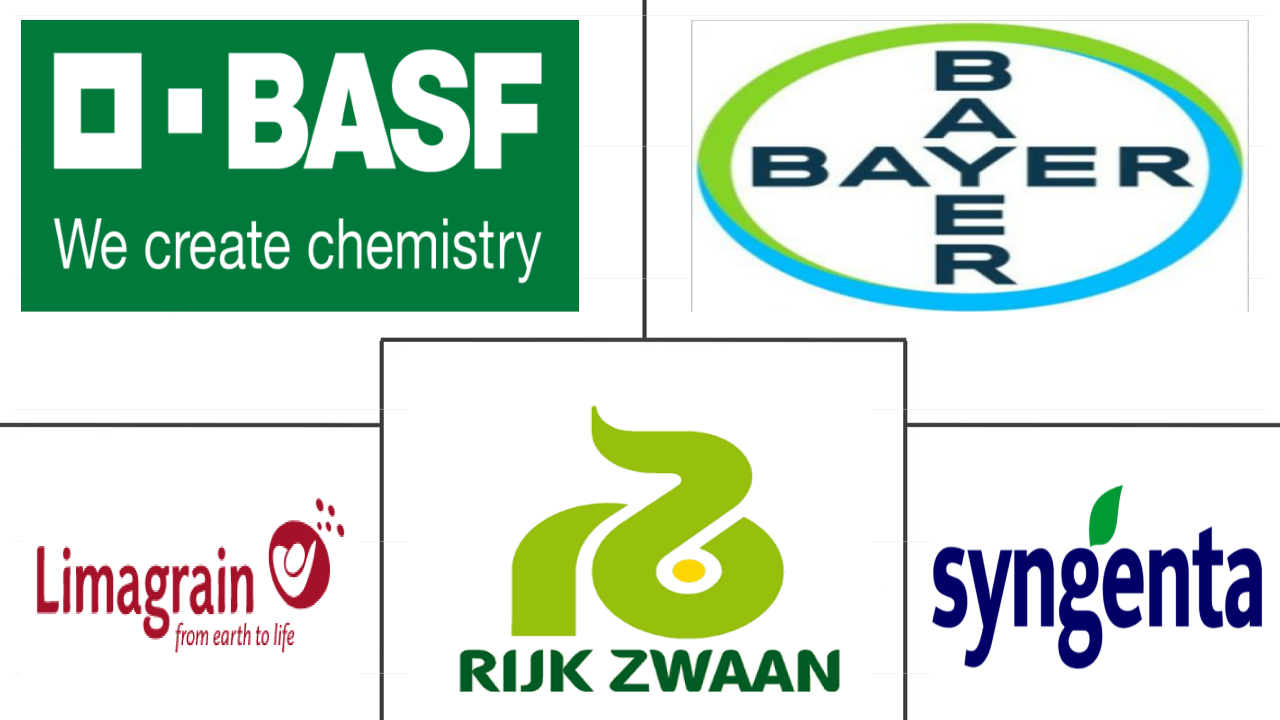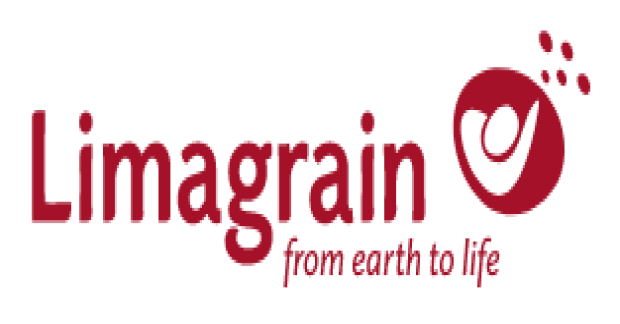Market Size of tomato seed Industry
| Icons | Lable | Value |
|---|---|---|
|
|
Study Period | 2017 - 2030 |
|
|
Market Size (2024) | USD 0.94 Billion |
|
|
Market Size (2030) | USD 1.34 Billion |
|
|
Largest Share by Breeding Technology | Hybrids |
|
|
CAGR (2024 - 2030) | 5.97 % |
|
|
Largest Share by Region | Asia-Pacific |
|
|
Market Concentration | Medium |
Major Players |
||

|
||
|
*Disclaimer: Major Players sorted in no particular order |
Tomato Seed Market Analysis
The Tomato Seed Market size is estimated at 0.94 billion USD in 2024, and is expected to reach 1.34 billion USD by 2030, growing at a CAGR of 5.97% during the forecast period (2024-2030).
0.94 Billion
Market Size in 2024 (USD)
1.34 Billion
Market Size in 2030 (USD)
5.87 %
CAGR (2017-2023)
5.97 %
CAGR (2024-2030)
Largest Market by Breeding Technology
74.73 %
value share, Hybrids, 2023
The major companies are developing new hybrids. The adoption of hybrids is high due to disease resistance, increased shelf life, high yield, and wider adaptability.
Largest Market by Country
20.50 %
value share, China, 2023
The rising economy and government policies supporting farmers' access to high-quality, improved seed varieties are the primary factors propelling the market's growth.
Fastest-growing Market by Breeding Technology
6.07 %
Projected CAGR, Hybrids, 2024-2030
The inherent characteristics such as high vigor, resistance to biotic and abiotic stresses, and increasing area under protected cultivation help the segment to grow.
Fastest-growing Market by Country
8.33 %
Projected CAGR, United States, 2024-2030
The demand for tomato seeds increased because of the increase in the consumption of tomatoes, demand by processing industries, and the increase in protected cultivation.
Leading Market Player
15.93 %
market share, Groupe Limagrain, 2022

It is mainly focused on product innovations and partnerships. Recently, it launched the first tomato varieties resistant to tomato brown rugose fruit virus (ToBRFV) in the market.
Hybrids dominated the market due to the higher yield and disease resistance traits
- Tomato is one of the major vegetable crops cultivated globally. It accounted for 12.4% of the global vegetable seed market in 2022 as a result of the demand for tomatoes in processing and fresh consumption.
- In 2022, open pollinated varieties and hybrid derivatives accounted for 27.2% of the global tomato seed market. This is expected to increase due to the increase in organic cultivation and preference for native varieties.
- Asia-Pacific was the largest region for the cultivation of tomatoes by using open pollinated varieties and hybrid derivatives, accounting for 58.3% in 2022. This is a result of an increase in the usage of open pollinated varieties in developing countries and the preference for their taste and quality over hybrids.
- The hybrid segment accounted for 72.8% of the global tomato seed market, and it is growing at a faster rate compared to OPVs due to the increase in consumption and demand from processing industries. The usage of hybrids, which have higher adaptability, is also increasing in the protected structures.
- Asia-Pacific had the largest share of the global hybrid tomato seed market, and it accounted for about 43% in 2022 because of the new advanced technologies available in the region. China is a global leader in protected cultivation, and only hybrid seeds can be used for protected cultivation.
- Major companies, such as Syngenta, Bayer AG, and Rijk Zawann, are developing new hybrids with disease-resistant traits, increasing shelf life, wider adaptability, high yield, strong stem, crack resistance, and high vigor. The increase in organic cultivation and fresh segment consumption is also expected to drive the open pollinated varieties tomato seed market during the forecast period.
Asia-Pacific is the major market for tomato seeds due to high area under cultivation and the adoption of protected cultivation
- Tomato is the most popular vegetable globally, with an overall production of around 189.1 million metric ton in 2021. It represented around 16.4% of the global vegetable production. In 2022, the tomato seeds market accounted for 12.4% of the global vegetable seed market, which is considered to be one of the largest vegetable seed markets in the world. This is associated with tomatoes being the most consumed vegetable in various preparations.
- In 2022, Asia-Pacific was the largest tomato seed market, accounting for 47.3% of the global tomato seed market. It is expected to grow further due to the increase in consumption and market value in the domestic and international markets. In the region, China was the largest country in the tomato seed market, accounting for 23.5% of the global tomato seed market in 2022. With the increase in hybrid availability, most of the tomatoes are grown in greenhouses, which accounted for more than 50% of China's total tomato production in 2022.
- North America is the second-largest region in the tomato seed market, accounting for 21.4% of the global tomato seed market in 2022. The United States is the largest consumer of tomatoes globally.
- With the increased usage of hybrids in the production of tomatoes worldwide, the demand for hybrid tomato seeds increased. In 2022, hybrid seeds accounted for 72.7% of the global tomato seed market.
- An increase in protected cultivation acreage in major producing countries and an increase in the demand from processing industries and for consumption are anticipated to drive the global tomato seed market, registering a CAGR of 6.1% during the forecast period.
Tomato Seed Industry Segmentation
Hybrids, Open Pollinated Varieties & Hybrid Derivatives are covered as segments by Breeding Technology. Open Field, Protected Cultivation are covered as segments by Cultivation Mechanism. Africa, Asia-Pacific, Europe, Middle East, North America, South America are covered as segments by Region.
- Tomato is one of the major vegetable crops cultivated globally. It accounted for 12.4% of the global vegetable seed market in 2022 as a result of the demand for tomatoes in processing and fresh consumption.
- In 2022, open pollinated varieties and hybrid derivatives accounted for 27.2% of the global tomato seed market. This is expected to increase due to the increase in organic cultivation and preference for native varieties.
- Asia-Pacific was the largest region for the cultivation of tomatoes by using open pollinated varieties and hybrid derivatives, accounting for 58.3% in 2022. This is a result of an increase in the usage of open pollinated varieties in developing countries and the preference for their taste and quality over hybrids.
- The hybrid segment accounted for 72.8% of the global tomato seed market, and it is growing at a faster rate compared to OPVs due to the increase in consumption and demand from processing industries. The usage of hybrids, which have higher adaptability, is also increasing in the protected structures.
- Asia-Pacific had the largest share of the global hybrid tomato seed market, and it accounted for about 43% in 2022 because of the new advanced technologies available in the region. China is a global leader in protected cultivation, and only hybrid seeds can be used for protected cultivation.
- Major companies, such as Syngenta, Bayer AG, and Rijk Zawann, are developing new hybrids with disease-resistant traits, increasing shelf life, wider adaptability, high yield, strong stem, crack resistance, and high vigor. The increase in organic cultivation and fresh segment consumption is also expected to drive the open pollinated varieties tomato seed market during the forecast period.
| Breeding Technology | |
| Hybrids | |
| Open Pollinated Varieties & Hybrid Derivatives |
| Cultivation Mechanism | |
| Open Field | |
| Protected Cultivation |
| Region | ||||||||||||||||||
| ||||||||||||||||||
| ||||||||||||||||||
| ||||||||||||||||||
| ||||||||||||||||||
| ||||||||||||||||||
|
Tomato Seed Market Size Summary
The tomato seed market is a significant segment within the global agricultural industry, driven by the high demand for tomatoes both for fresh consumption and processing purposes. As one of the most cultivated vegetable crops worldwide, tomatoes represent a substantial portion of the global vegetable seed market. The market is characterized by a diverse range of seed varieties, including open pollinated varieties (OPVs) and hybrids, with the latter gaining prominence due to their adaptability and higher yield potential. The Asia-Pacific region, particularly China, plays a pivotal role in the market, leveraging advanced agricultural technologies and protected cultivation methods to enhance production. Major agricultural companies are actively developing new hybrid seeds with desirable traits such as disease resistance, extended shelf life, and adaptability to various climatic conditions, further propelling market growth.
The market is expected to experience steady expansion over the forecast period, driven by increasing consumption and demand from both domestic and international markets. The hybrid segment, in particular, is anticipated to grow at a faster rate due to its widespread adoption in protected cultivation and its suitability for diverse agro-ecological conditions. The rise in organic cultivation and the preference for native varieties are also contributing to the growth of OPVs. The tomato seed market is moderately consolidated, with leading companies holding a significant share, and ongoing innovations in seed technology are expected to sustain the market's upward trajectory. As the demand for tomatoes continues to rise, supported by the growing food processing industry, the global tomato seed market is poised for robust growth in the coming years.
Tomato Seed Market Size - Table of Contents
-
1. MARKET SEGMENTATION (includes market size in Value in USD, Forecasts up to 2030 and analysis of growth prospects)
-
1.1 Breeding Technology
-
1.1.1 Hybrids
-
1.1.2 Open Pollinated Varieties & Hybrid Derivatives
-
-
1.2 Cultivation Mechanism
-
1.2.1 Open Field
-
1.2.2 Protected Cultivation
-
-
1.3 Region
-
1.3.1 Africa
-
1.3.1.1 By Breeding Technology
-
1.3.1.2 By Cultivation Mechanism
-
1.3.1.3 By Country
-
1.3.1.3.1 Egypt
-
1.3.1.3.2 Ethiopia
-
1.3.1.3.3 Ghana
-
1.3.1.3.4 Kenya
-
1.3.1.3.5 Nigeria
-
1.3.1.3.6 South Africa
-
1.3.1.3.7 Tanzania
-
1.3.1.3.8 Rest of Africa
-
-
-
1.3.2 Asia-Pacific
-
1.3.2.1 By Breeding Technology
-
1.3.2.2 By Cultivation Mechanism
-
1.3.2.3 By Country
-
1.3.2.3.1 Australia
-
1.3.2.3.2 Bangladesh
-
1.3.2.3.3 China
-
1.3.2.3.4 India
-
1.3.2.3.5 Indonesia
-
1.3.2.3.6 Japan
-
1.3.2.3.7 Myanmar
-
1.3.2.3.8 Pakistan
-
1.3.2.3.9 Philippines
-
1.3.2.3.10 Thailand
-
1.3.2.3.11 Vietnam
-
1.3.2.3.12 Rest of Asia-Pacific
-
-
-
1.3.3 Europe
-
1.3.3.1 By Breeding Technology
-
1.3.3.2 By Cultivation Mechanism
-
1.3.3.3 By Country
-
1.3.3.3.1 France
-
1.3.3.3.2 Germany
-
1.3.3.3.3 Italy
-
1.3.3.3.4 Netherlands
-
1.3.3.3.5 Poland
-
1.3.3.3.6 Romania
-
1.3.3.3.7 Russia
-
1.3.3.3.8 Spain
-
1.3.3.3.9 Turkey
-
1.3.3.3.10 Ukraine
-
1.3.3.3.11 United Kingdom
-
1.3.3.3.12 Rest of Europe
-
-
-
1.3.4 Middle East
-
1.3.4.1 By Breeding Technology
-
1.3.4.2 By Cultivation Mechanism
-
1.3.4.3 By Country
-
1.3.4.3.1 Iran
-
1.3.4.3.2 Saudi Arabia
-
1.3.4.3.3 Rest of Middle East
-
-
-
1.3.5 North America
-
1.3.5.1 By Breeding Technology
-
1.3.5.2 By Cultivation Mechanism
-
1.3.5.3 By Country
-
1.3.5.3.1 Canada
-
1.3.5.3.2 Mexico
-
1.3.5.3.3 United States
-
1.3.5.3.4 Rest of North America
-
-
-
1.3.6 South America
-
1.3.6.1 By Breeding Technology
-
1.3.6.2 By Cultivation Mechanism
-
1.3.6.3 By Country
-
1.3.6.3.1 Argentina
-
1.3.6.3.2 Brazil
-
1.3.6.3.3 Rest of South America
-
-
-
-
Tomato Seed Market Size FAQs
How big is the Global Tomato Seed Market?
The Global Tomato Seed Market size is expected to reach USD 943.09 million in 2024 and grow at a CAGR of 5.97% to reach USD 1.34 billion by 2030.
What is the current Global Tomato Seed Market size?
In 2024, the Global Tomato Seed Market size is expected to reach USD 943.09 million.

